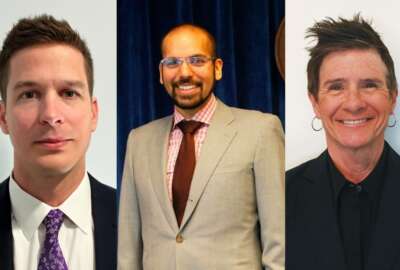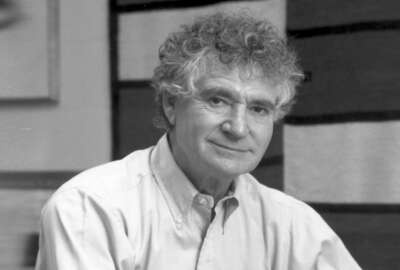
Using flowers to solve crimes
Wherever you go, the local plants put pollen on your body and it stays there. That's the basis for a forensic science that's helped solve all sorts of crimes.
Best listening experience is on Chrome, Firefox or Safari. Subscribe to Federal Drive’s daily audio interviews on Apple Podcasts or PodcastOne.
Did you know that wherever you go, the local plants put pollen on your body and it stays there. That’s the basis for a forensic science that’s helped solve all sorts of crimes. My guest practices pollen science, called palynology, at the Customs and Border Protection laboratory in Chicago. For her work she’s a finalist in this year’s Service to America Medals Program. Dr. Shannon Ferguson joined Federal Drive with Tom Temin to discuss.
Interview transcript:
Tom Temin: Dr. Ferguson. Good to have you on.
Dr. Shannon Ferguson: Good to see here. Thanks for having me.
Tom Temin: And maybe you can explain it a little better than I did what a pollenologist does in the first place.
Dr. Shannon Ferguson: Pollenologist are interested in using pollen and spores for a variety of applications. A majority of pollenologist are in academia studying either paleo climate change. And there’s also some that will use it in the industry as well for biostratigraphy. But Andy and I use technology for forensic purposes in order to help use it as a geolocation tool for trade compliance, criminal investigations and counterterrorism endeavors.
Tom Temin: Alright. And Andy is Dr. Andrew Lawrence. He’s your co finalist and also works in the lab there at CBP. Well what is it about pollen that can help trace things and identify dead bodies and so on.
Dr. Shannon Ferguson: We use it for geolocation, and it’s based on pollen because each plant in the world has a pollen grain that is specific to it. And each pollen grain has a unique morphology. So pollen is also composed of chemically resistant organic compounds, and so it preserves remarkably well and resists all types of degradation and microbial attacks. So we can use it to basically pollen print wherever something has been.
Tom Temin: So if I go hiking somewhere in a national forest, I will carry with me a pollen marker of where I’ve been.
Dr. Shannon Ferguson: Mhmm. You will collect pollen from the area, it’s called pollen rain. So wherever you are in the world, there’s plants that are putting out pollen, and we collect them unwittingly. And so each pollen print from a region is unique and it allows us to link it to a specific region.
Tom Temin: And how does this work in the context of Customs and Border Protection?
Dr. Shannon Ferguson: Whenever we have something that comes in, for instance, for trade compliance issues, or there’s a criminal investigation that they need to know where this person has been or where a vehicle has been that’s been smuggling drugs, we can use the pollen profile to give them an idea of where it’s been and help them in their investigations.
Tom Temin: And your SAMMIES award citation described the identification of someone who was discovered, their body was discovered in 1981 and then identified in 2018. How did that work?
Dr. Shannon Ferguson: It was a cold case and they didn’t have any information of where Marcia King a king had been from. So it just kept being put as a cold case, but then they finally sent in some clothes to us, and we were able to see that she had pollen from the eastern forest on hair such as hemlock and spruce. But she was found out west and those pollen grants are not found out there. So she also was covered and like ephedra and other Western pollen profiles as well since her body was dumped out there. But since she had other pollen types on her that were not from the region, and that really helps investigators figure out where she was from.
Tom Temin: So you couldn’t solve the murder but at least you could identify someone who was lost to loved ones all those years earlier.
Dr. Shannon Ferguson: Yeah. So it’s just really helpful to help narrow down investigation and help the police or whoever it is just really hone in on their resources.
Tom Temin: So at CBP, you solve CBP issues and the lab is also available to other federal agencies, isn’t it? You do work across government?
Dr. Shannon Ferguson: Yeah, we’re not just here for US Customs and Border Protection. We serve anybody that we can, and it’s free of charge as well, because we just feel like it’s best to help as many people as possible. And we’re available to do that and help any opportunity we can.
Tom Temin: Maybe some other examples of interesting things you’ve discovered through palynology?
Dr. Shannon Ferguson: Yeah, so Andy and I have worked over 400 cases, again for CBP and otherwise. We have worked on three cases for National Center for Missing and Exploited Children that have resulted in identification and we just always help in trade for CBP, we help again in smuggling for vehicles that go across the border to figure out where they were located. Yeah, just the various amounts of things.
Tom Temin: And is there some sort of a map of pollen across the country? You said every plant has a unique pollen and spore that it puts out. But do they generally resemble one another in a region so that you could say, well this spore is from the upper Northwest and that one is from the lower Southeast.
Dr. Shannon Ferguson: No it doesn’t work quite that way. For instance, like a pine tree will have like the same morphology no matter where that pine tree is located. But based on if we find a pine grain, and also an oak grain, we look at as like an assemblage, we say like upon assemblage. So each species of plant is just a part of the puzzle. So we look at everything that is present, and then we see how much percentage of each and then we can tell based on that and research that’s been done previously, where we are located. It’s like a whole package, but each grain looks the same no matter where it is
Tom Temin: Got it. And to look at a grain I guess your main tool for your work is the microscope?
Dr. Shannon Ferguson: Definitely yeah. Andy and I spend so much time on the microscope, we do it all by hand, it doesn’t like do it automatically for us or anything. So we just scan transects of our slides and then individually tally and count each pollen grain that we encounter.
Tom Temin: I mean, I’ve got an old microscope I used in high school, and they had little I guess they were about one inch by three inch glass slides. Some of them had a little dish in them. Still the same tools used now?
Dr. Shannon Ferguson: Yeah, it’s basically the same, you just need a microscope just like that. And we also just have a camera on top so we can take pictures of them. And also just compare and if we have unknown then you talk to one another about them and figure that out, which is always really fun. And then yeah, it’s just either we’re in the lab processing the samples or on the microscope, counting the sample.
Tom Temin: And when you go out and about, say on your own time do you take the pollen off yourself and take a look at it and maybe delve deeper into the soil palynology?
Dr. Shannon Ferguson: We have before Yeah. And it’s really fun to like vacuum yourself, your clothes for pollen. And also just take like random soil samples from around as well for reference samples.
Tom Temin: Sure. I imagine dogs are great sources of palynology.
Dr. Shannon Ferguson: Definitely, mostly grass though from rolling around.
Tom Temin: But sounds like you enjoy your work?
Dr. Shannon Ferguson: Oh yeah, definitely. It’s always fun. It’s always new. It’s never is boring.
Tom Temin: Wow. Dr. Shannon Ferguson is a paleontologist with Customs and Border Protection, and along with colleague Dr. Andrew Lawrence, a finalist in this year’s Service to America Medals program. Thanks so much for joining me.
Dr. Shannon Ferguson: Thank you so much for having me.
Find more information about their work and finalist nomination here.
Copyright © 2025 Federal News Network. All rights reserved. This website is not intended for users located within the European Economic Area.
Tom Temin is host of the Federal Drive and has been providing insight on federal technology and management issues for more than 30 years.
Follow @tteminWFED





